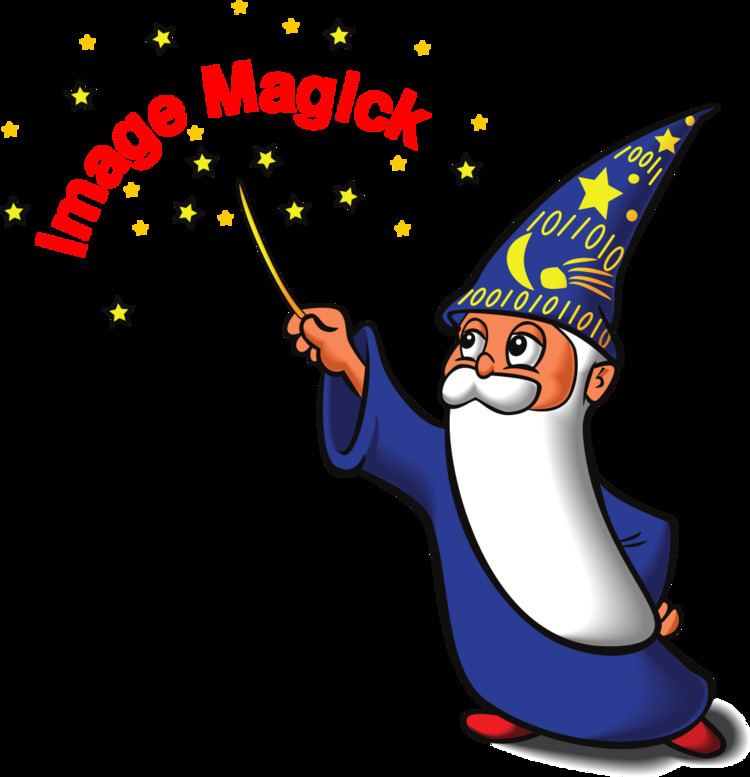Original author(s) Written in C | Developer(s) ImageMagick Studio LLC | |
 | ||
Initial release August 1, 1990; 26 years ago (1990-08-01) Stable release 7.0.4-10 / 18 February 2017; 19 days ago (2017-02-18) Repository git.imagemagick.org/repos/ImageMagick.git | ||
ImageMagick is a free and open-source software suite for displaying, converting, and editing raster image and vector image files. It can read and write over 200 image file formats.
Contents
History
ImageMagick was created in 1987 by John Cristy when working at DuPont, to convert 24-bit images (16 million color) to 8-bit images (256-color), so they could be displayed on most screens. It was freely released in 1990 when DuPont agreed to transfer copyright to ImageMagick Studio LLC, still currently the project maintainer organization.
In May 2016, it was reported that ImageMagick had a vulnerability through which an attacker can execute arbitrary code on servers that use the application to edit user-uploaded images. Security experts including CloudFlare researchers observed actual use of the vulnerability in active hacking attempts.
Features and capabilities
The software mainly consists of a number of command-line interface utilities for manipulating images. ImageMagick does not have a robust graphical user interface to edit images as do Adobe Photoshop and GIMP, but does include – for Unix-like operating systems – a basic native X Window GUI (called IMDisplay) for rendering and manipulating images and API libraries for many programming languages.
Execute the following on Linux or UNIX to launch the GUI:
$ displayOtherwise, images may be edited directly by various command-line parameters without launching a GUI at all. The program uses magic numbers to identify image file formats.
For a full list of supported formats, execute, on Linux or UNIX:
$ identify -list formatA number of programs, such as Drupal, MediaWiki, phpBB, and vBulletin, can use ImageMagick to create image thumbnails if installed. ImageMagick is also used by other programs, such as LyX, for converting images.
ImageMagick has a fully integrated Perl bindings called PerlMagick, as well as many others: G2F (Ada), MagickCore (C), MagickWand (C), ChMagick (Ch), ImageMagickObject (COM+), Magick++ (C++), JMagick (Java), L-Magick (Lisp), NMagick (Neko/Haxe), MagickNet (.NET), PascalMagick (Pascal), MagickWand for PHP (PHP), IMagick (PHP), PythonMagick (Python), RMagick (Ruby), or TclMagick (Tcl/TK).
File format conversion
One of the basic and thoroughly-implemented features of ImageMagick is its ability to efficiently and accurately convert images between different file formats (it uses the command convert to achieve this).
Color quantization
The number of colors in an image can be reduced to an arbitrary number and this is done by intelligently weighing the most prominent color values present among the pixels of the image. Note that many other image handling applications do not support a color palette of an arbitrary number of colors. If, for example, one reduces an image to 13 colors via ImageMagick, some applications will open it but some will regard it as corrupted.
A related capability is the posterization artistic effect, which also reduces the number of colors represented in an image. The difference between this and standard color quantization is that while in standard quantization the final palette is selected based upon a weighting of the prominence of existing colors in the image, posterization creates a palette of colors smoothly distributed across the spectrum represented in the image. Whereas with standard color quantization all of the final color values are ones that were in the original image, the color values in a posterized image may not have been present in the original image but are in between the original color values.
Dithering
A fine control is provided for the dithering that occurs during color and shading alterations, including the ability to generate halftone dithering.
Liquid rescaling
In 2008, support for liquid rescaling was added. This feature allows, for example, rescaling 4:3 images into 16:9 images without distorting the image.
Artistic effects
ImageMagick includes a variety of filters and features intended to create artistic effects:
OpenCL
ImageMagick can use OpenCL to use an accelerated graphics card (GPU) for processing.
Deep color
The Q8 version supports up-to 8 bits-per-pixel component (8-bit grayscale, 24- or 32-bit RGB color). The Q16 version supports up-to 16 bits-per-pixel component (16-bit grayscale, up-to 48- or 64-bit RGB color).
Other
Below are some other features of ImageMagick:
Distribution
ImageMagick is cross-platform, and runs on Microsoft Windows and Unix-like systems including Linux, macOS, iOS, Android, Solaris, and FreeBSD. The project's source code can be compiled for other systems, including AmigaOS 4.0 and MorphOS. It has been run under IRIX.
Related software
GraphicsMagick is a fork of ImageMagick 5.5.2 made in 2002, emphasizing the cross-release stability of the programming API and command-line options. GraphicsMagick emerged after irreconcilable differences emerged in the developers' group.
